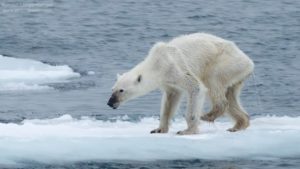
Above is a photo I found of an extremely emaciated polar bear, one that the photographer claimed only had a few days left to live. How did it make you feel? What were your initial thoughts when you saw it? Did you think of climate change and the impact humans have on the natural world? Did you think of the barren environment in which the bears live?
I wanted to continue on with another post similar to my last one on the usefulness, and power, that can come with images. We read Cohn’s piece on what images do for us and how they shape our lives, but this week’s readings delve a bit deeper into the “why” and “how” surrounding this topic.
Most of what is found in Breaking Down an Image, by Sheffield, is a continuation of Cohn’s work. She gives us a few basic ways to understand how a photographer or advertisement company might set a photo up as, but in my opinion, she fails to give us something new to push the bounds of what we already know about rhetoric. In the Psychology of Rhetorical Images, by Hill, he establishes something I never even thought of when it came to understand the “why” and “how” of an image and that is presence.
“the desired element receives the greatest amount of presence from being directly perceived”
Hill is explaining that words can only do but so much for us as humans. We want to experience things to fully understand them, and many of us (myself included) have difficulty understanding complex situations until we, ourselves, are faced with them. A photo, video, or some sort of visual representation is going to be the next best thing for us to be able to experience what we have not, and in this case, we are experiencing the sight of what happens when a habitat is reaching full destruction. The presence images have, especially in cases where a change needs to be made, can be vital. This photograph from 2015 garnered a huge following as it is quite undeniable that there is clearly something wrong and that something is the way humans have treated our environment.
More on the polar bear photo here: https://www.cbc.ca/news/trending/thin-bear-photo-kerstin-1.3232725
5 replies on “Breaking Down an Image, but what about presence? – Comparison”
This photo shows the importance of photos and their power. In this photo you can literally see the skeleton of a bear. This is a sad story, but without the photo we would not be able to understand its condition 100%. When people are dismissive of photos, they simply do not understand the importance and meaning of photos.
mexican pharmacy buying prescription drugs in mexico online mexico drug stores pharmacies
buy cipro: ciprofloxacin generic price – buy generic ciprofloxacin
http://indianpharm24.com/# online shopping pharmacy india indianpharm.store
http://prednisoneall.shop/# prednisone for sale online